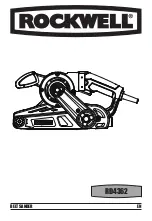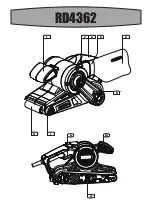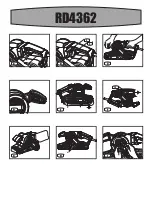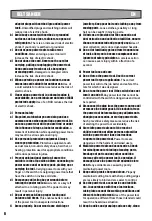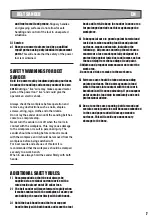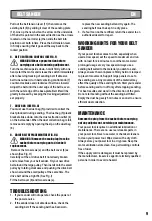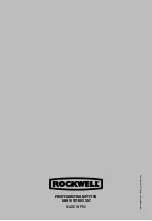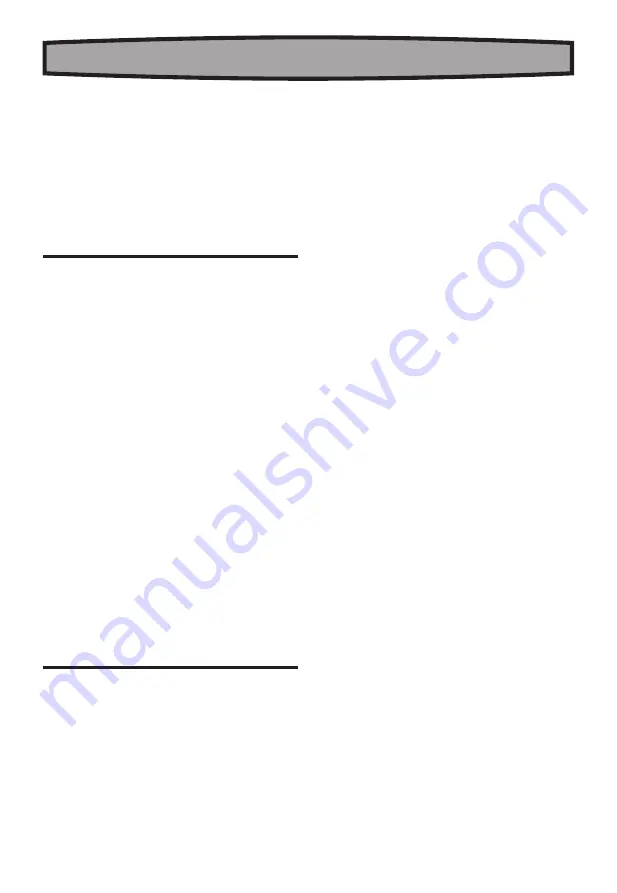
7
BELT SANDER
EN
and free from oil and grease.
Slippery handles
and grasping surfaces do not allow for safe
handling and control of the tool in unexpected
situations.
5) Service
a) Have your power tool serviced by a qualified
repair person using only identical replacement
parts.
This will ensure that the safety of the power
tool is maintained.
SAFETY WARNINGS FOR BELT
SANDER
Hold the power tool by insulated gripping surfaces,
because the sanding surface may contact its own
cord.
Cutting a “live” wire may make exposed metal
parts of the power tool “live” and could give the
operator an electric shock.
Always check the workpiece before operation and
remove any obstructions such as nails, staples,
screws, string, rags, cloths and other debris.
Do not lay the sander down until the sanding belt has
come to a complete stop.
Never turn the sander on or off when the tool is in
contact with the workpiece. This may cause damage
to the workpiece or result in personal injury. The
sander should be running before contact is made
with the workpiece and it should be removed from the
workpiece before being switched off.
For best results and safe use of this tool it is
recommended that the workpiece should be clamped
securely to a work bench.
When in use always hold the sander firmly with both
hands.
ADDITIONAL SAFETY RULES:
1) Recommendation that the tool always be
supplied via a residual current device with a
rated residual current of 30 mA or less.
2) The belt sander will move forward rapidly when
it makes contact with the workpiece. Ensure you
are holding the sander firmly with both hands.
3) Hold the back handle and the front support
handle firmly with both hands and move the tool
back and forth. Do keep the sander in once area
for prolonged periods as this may damage the
workpiece.
4) Take special care to guard against harmful and
toxic dusts when sanding lead-based painted
surfaces, woods and metals, including the
following: - All persons entering the work area
must wear a face mask specially designed for
protection against toxic dust and fumes such as
those arising from the sanding of lead paint.
- Children and pregnant women must not enter the
work area.
- Do not eat, drink or smoke in the work area.
5) Extreme care should be taken when sanding
painted surfaces. The dust may contain lead
which if comes into contact with the skin or is
breathed in will cause poisoning. If you suspect
paint contains lead stop immediately and seek
professional advice.
6) Do not use the same sanding belt for wood and
metal as metal particles will become embedded
in the sand paper and will damage wooden
surfaces. This will avoid any unnecessary
damage to the base.
Summary of Contents for RD4362
Page 1: ...RD4362 BELT SANDER EN...
Page 2: ......
Page 3: ...RD4362 6 5 1 3 7 11 8 4 2 9 10...
Page 4: ...RD4362 2 a a 2 9 12 A B C D E F G H I...
Page 10: ......
Page 11: ......

